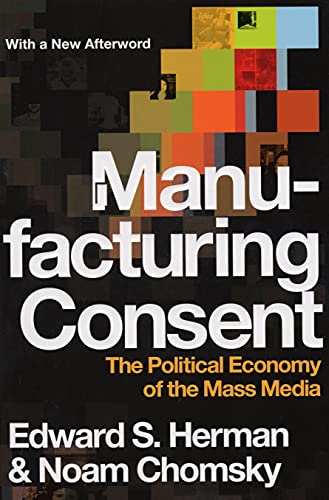An animation video created based on a book titled ‘Manufacturing Consent’ by Noam Chomsky and David S Herman published in 1988 about the function of the media in the world containing strong arguments about the similar role the media plays compared to official government communication networks but largely promoted as ‘independent’ or ‘free institution’ to sustain and protect power instead of serving as the source of reliable information and a vital check on power to praphrase the words of the author who wrote an article titled ‘Is mass media still ‘manufacturing consent’ in the internet age?’ in which a link to the related video is featured. The 5 media filters which are used to ultimately determine what to broadcast as news to the public, per Chomsky and Herman, are also described and mentioned in this short video lasting under 5 minutes long. The video features visuals and was created by a filmmaker called Pierangelo Pirak for The Listening Post by Al Jazeera TV. This video is very informative for a brief explanation on the topic of manufacturing consent and the book in question by the above 2 named authors.
Since the book was published over 30 years ago, there has been countless and endless research conducted on manufacturing consent including analysis on the original arguments stated in the groundbreaking book. Chomsky and his co-author argue mainly that the media chooses selectively what news to publish to the world depending on the selfish or personal reasons behind outlets and networks instead of providing news content of interest to readers and viewers. In his book, he also suggests ways for someone to become a well-informed citizen concerning consuming news from the media. The book also explains his argument of how the upper classes in society skews or controls what type of news stories are served to the public for general consumption in a deeply-entrenched system lasting for quite some time before the internet age which still remains a relevant concern when discussing the indepdence of the media institutions from influence. 3 main points Chomsky argued include that the media publish news favouring advertisers for revenue generating purposes, that experts whom feature in news reports to give information is essentially the upper class controlling what is disseminated to the public and that events are covered mostly in a way that favours the elite ruling class amongst society. These are all valid arguments which have since been reviewed and evaluated more recently especially with the rise of the internet usage by media institutions to transmit news and more to people.
In terms of my personal opinion of whether consent is still an important factor in the creating of news stories in today’s digital world, it doesn’t matter so much due to the widely free circulation of stories of all types to the public themselves within different social classes not just by media institutions but by private individual citizens unrelated to thejournalism profession which has reduced the requirement of consent in covering news stories compared to previous eras. With social media journalism, citizen reporting and publishing of photos or videos informally across the internet, it enables less of the way consent is manufactured within the media currently but that networks and advertisers and upper class individuals still have significant influence in ordinary news production.


I watched that video, and it gave me a clear visual view of how news is filtered through five filters from the top of society to the masses. We don’t see the truth they don’t want to show us. Although we are now allowed to post photos or videos informally on the Internet, what we upload is also subject to censors, and we still use media within the framework they have set for us.